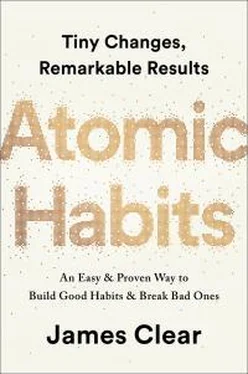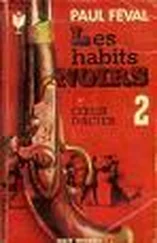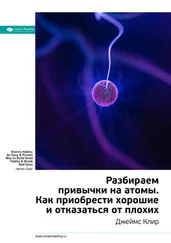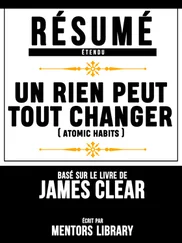Plateau of Latent Potential, 21–23
pleasure
anticipating vs. experiencing, 106–108
image of, 260
repeating a behavior when it’s a satisfying sensory experience, 184–86, 264
Safeguard soap example, 184–85
Plomin, Robert, 220
Pointing-and-Calling subway safety system, 62–63
positive compounding, 19
The Power of Habit (Duhigg), 9, 47n
predictions, making
after perceiving cues, 128–29
the human brain as a prediction machine, 60–61
Premack, David, 110
Premack’s Principle, 110
pride
manicure example, 33
in a particular aspect of one’s identity, 33–34
priming your environment to make the next action easy, 156–58
problem phase of a habit loop, 51–53
process and behavior change, 30–31
professionals vs. amateurs, 236
progress, 262
proximity’s effect on behavior, 116–18
quitting smoking, 32, 125–26
reading resources
Atomic Habits newsletter, 257
business applications of habit strategies, 265
parenting applications of habit strategies, 267
recovering when habits break down, 200–202
reflection and review
author’s Annual Review and Integrity Report, 245–46
benefits of, 246–47
Career Best Effort program (CBE) example, 242–44
Chris Rock example, 245
Eliud Kipchoge example, 244–45
flexibility and adaptation, 247–49
importance of, 244–45
Katie Ledecky example, 245
reframing habits to highlight their benefits, 131–32
reinforcement, 191–93
repetition
as active practice of a new habit, 144
automaticity, 144–46
to master a habit, 143
photography class example of active practice, 141–42, 144
responding to things based on emotions, 261–62
rewards
after sacrifice, 262
immediate vs. delayed, 187–90
purpose of, 49
reinforcement, 191–93
training yourself to delay gratification, 190–93
variable rewards, 235
“wanting” vs. “liking,” 106–108, 263
Riis, Jacob, 21
Riley, Michael, 60
Riley, Pat, 242–44
Ritty, James, 171–72
Robins, Lee, 91–92
sacrifice, 262
satisfaction
as the completion of the habit loop, 186
and expectations, 262–63
pleasurable sensory experiences, 184–86
2nd Law of Behavior Change (Make It Attractive)
ABC Thursday night TV lineup example, 109
desire for approval, respect, and praise, 121–22
habit tracking, 198
highly engineered versions of reality, 104
making the cues of bad habits unattractive, 126
supernormal stimuli, 102
temptation bundling, 108–11
Seinfeld, Jerry, 196–97
self-control
controlling the environment to achieve, 92–93
cue-induced wanting, 93–94
difficulty of, 262
riding and smoking example of controlling your environment, 93
as a short-term strategy, 95
the senses
Safeguard soap example, 184–85
toothpaste example of a satisfying behavior change, 186
vision, 84, 85–87
Wrigley chewing gum example, 185
showing up, mastering the art of, 163–64, 201–202, 236
Skinner, B. F., 9–10, 235n
smoking, quitting, 32, 125–26
social media, 174–75
social norms
Asch’s social conformity line experiments, 118–20
downside of going along with the group, 120–21
herd mentality, 115
imitation of others’ habits
the close, 116–18
the many, 118–21
the powerful, 121–22
solution phase of a habit loop, 51–53
Sorites Paradox, 251–52
starting a habit, 71–72
Steele, Robert, 91
Stern, Hawkins, 83
success
accepting where your strengths are, 218–19
importance of feeling successful, 190
suffering, 262
suggestion impulse buying, 83
supernormal stimuli, 102
Suroweicki, James, 154
System 1 vs. System 2 thinking, 232n, 261
systems
changes to solve problems, 25
as a cycle of continuous improvement, 26–27
vs. goals, 23–24
technology
for automating a habit, 173–75
social media, 174–75
temptation bundling, 108–11
3rd Law of Behavior Change (Make It Easy)
agricultural expansion example of using the least effort, 149–51
energy requirements and likelihood of action, 151–52
friction associated with a behavior, 152–58
garden hose example of reducing friction, 153
“gateway habit,” 163
Japanese factory example of addition by subtraction, 154–55
making the cues of bad habits difficult, 169–70
onetime actions that lead to better habits, 172–74
Principle of Least Action, 151n
repetition as the key to habit formation, 146–47
Two-Minute Rule, 162–67
Twyla Tharp example of a daily ritual, 159–60
Thorndike, Anne, 81–82
Thorndike, Edward, 43–44
time inconsistency, 188–89
Tinbergen, Niko, 101–102
toothpaste example of a satisfying behavior change, 186
tracking a habit
automated, 199
combining habit stacking with habit tracking, 200
manual, 199–200
usefulness of, 202–204
trajectory of your current path, 18
two-step process of changing your identity, 39–40
Uelsmann, Jerry, 141–42
Ulysses pact (Ulysses contract), 170n
underlying motives and cravings, 127–28, 130
Valley of Disappointment, 20, 22
variable rewards, 235
Vietnam War heroin addiction problem, 91–92
vision
impact on human behavior, 84
obvious visual cues, 85–87
visual measurements, 195–96
weight loss
nonscale victories, 203–204
using a habit contract to ensure, 208–209
Yerkes-Dodson law, 232
ABCDEFGHIJKLMNOPQRSTUVWXYZ
About the Author
James Clear's work has appeared in the New York Times , Time , and Entrepreneur , and on CBS This Morning , and is taught in colleges around the world. His website, jamesclear.com, receives millions of visitors each month, and hundreds of thousands subscribe to his email newsletter. He is the creator of The Habits Academy, the premier training platform for organizations and individuals that are interested in building better habits in life and work.
What’s next on
your reading list?
Discover your next
great read!
Get personalized book picks and up-to-date news about this author.
Sign up now.
* Interested readers can learn more at habitsacademy.com.
* As this book was going to print, new information about the British Cycling team has come out. You can see my thoughts at atomichabits.com/cycling.
* I geeked out and actually calculated this. Washington, D.C., is about 225 miles from New York City. Assuming you are flying on a 747 or an Airbus A380, changing the heading by 3.5 degrees as you leave Los Angeles likely causes the nose of the airplane to shift between 7.2 to 7.6 feet, or about 86 to 92 inches. A very small shift in direction can lead to a very meaningful change in destination.
* The terms unconscious , nonconscious , and subconscious can all be used to describe the absence of awareness or thought. Even in academic circles, these words are often used interchangeably without much nitpicking (for once). Nonconscious is the term I’m going to use because it is broad enough to encompass both the processes of the mind we could never consciously access and the moments when we are simply not paying attention to what surrounds us. Nonconscious is a description of anything you are not consciously thinking about.
Читать дальше




![Джеймс Клир - Атомные привычки [Как приобрести хорошие привычки и избавиться от плохих]](/books/403243/dzhejms-klir-atomnye-privychki-kak-priobresti-horosh-thumb.webp)



